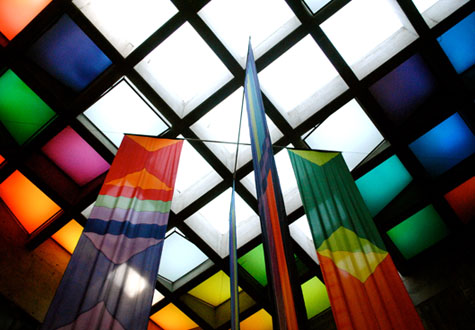Being a student at the University of Western Ontario requires a lot of walking around campus and becoming familiar with its various buildings. One of our largest, situated at the northwest end of the London location, is the Social Sciences Centre (figure 1). The structure, home of the Faculty of Social Sciences, consists of nine levels, the Serge A. Sauer Map Library, G.L Reuber Lecture Theatre, and numerous laboratories and classrooms. Juxtaposed against the decorative, early-20th century Collegiate-Gothic campus buildings, the 1970s Brutalist-styled Social Sciences Centre seems rather ominous, an unsophisticated addition to the University’s grounds (figure 2). Many have complained about this typical Brutalist building, finding it unfriendly and out of place.
However, despite its criticism, there is inherent beauty to be found at the Social Sciences Centre. The Stairwell and Atrium of the building, designed by Christopher Wallis, features a precise arrangement of coloured stained-glass squares (figure 3). The Faculty of Social Science, McIntosh Gallery, and the province of Ontario jointly sponsored the project in 1985, and it was completed in 1986. This installation is visible from floors one to four, and is centered in the ceiling of these levels. The glass itself is creatively engineered, responding to the changing light of environmental conditions. The wide staircase, situated directly below the glass installation, is appropriate for the amount of foot traffic it receives on a daily basis. Its simplistic design made of brick-like tiles and concrete is also typical of Brutalism, but is rendered more approachable by natural light streaming from the ceiling.
Wallis’ Atrium has served as a well-travelled gateway within the Social Science Centre for twenty-five years. Yet, it remains unnoticed to the majority of its patrons. Last Friday, on September 23, 2011, I visited this magnificent space and focused my attention upon its aesthetic value. To my surprise, what I found not only pleased me visually, but allowed me to realize the space’s conventional importance.
I approached the Atrium from the main doors of the building, which face the interior of Western’s campus. Upon entering the building, the first thing I noticed was the vast space, a wide corridor suitable for large amounts of daily foot traffic. The space was significantly crowded as students and staff members hurried to their designated locations. Typically, the building received different volumes of traffic throughout the day, the busiest times being just before and shortly after respective classes. It was loud at the time of my visit, with sounds of constant footsteps, chatter, and churning power generators echoing into far corners of the building. Approaching the staircase, I noticed the immense width of the steps, appropriate for considerable amounts of people travelling it daily. It is made out of durable materials; concrete, metal, and brick-like tiles. Looking up, I noticed the true marvel of this forgotten space. The skylight completed with blue, green, yellow, purple, red, and orange glass panels, filtered natural light to the first four floors of the building. Four long, colourful curtains hang from these glass squares; their patterns depicting the coloured light filtering into the structure’s depths (figure 4). My eyes then followed the curtains downwards to a basement concourse filled with tables used for student interaction, eating, and studying. As I moved through this space, I found myself adjusting to an indoor urban landscape. The constant circular flow of foot traffic around the Atrium and Staircase forced me to move swiftly, travelling amongst other students and faculty members.
This space is certainly designed for resource and accessibility. It is essential for such a large building as the Social Sciences Centre to possess such a place, since it organizes the circulation of foot traffic to, from, and within the structure. It is located at the building’s central core, indicating its purpose as the building’s main portal. However, not only did I determine this space as a key gateway, but realized its importance as a meeting place as well. I found myself surrounded by social groups, either intentional meetings or casual run-ins. The high ceilings and vast space enforce the opportunity for communication, welcoming the development of crowds.
As I mentioned before, the elements of the Social Science Centre Atrium and Stairwell reflect a typical 1970s Brutalist style. Brutalism refers to the French “breton brut,” which can be defined as “raw concrete.” To find out more about Brutalism, along with examples of other Brutalist-designed buildings visit this site. The majority of these structures, including the Social Sciences Centre, are fabricated with poured board-marked concrete to reveal the texture of the wooden forms used for casting. A common theme in Brutalism is also to expose the building’s intended function. The simplistic, angular design of Wallis’ staircase directly implies its purpose of a gateway (figure 5). To offset the staircase’s crude design, the colourful arrangement of stained glass squares provides a welcoming atmosphere for the Social Sciences Centre. Without the contribution of natural light, the space can be mundane and unfriendly. Also, the banners hanging from the installation could have been an afterthought to keep the space lively in times where no natural light is present.
Upon leaving the space, I realized the importance of such bright, vivid installations in simplistic post-modern designed buildings. Wallis’ Atrium and staircase bring character into a structure that essentially reduces the design of other stylistic campus buildings. It enhances the quality of light inside the building, while also acting as a key gateway and social gathering place. Due to its central position, it really does enforce an important indoor urban landscape. We are lucky to have creatively-engineered spaces like this on our campus to engage, intrigue, and simply to allow us to love attending such a great University.
|













